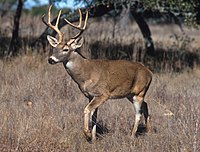
Photo from wikipedia
Abstract The past century witnessed a dramatic increase in deer abundance in North America, Western Europe, and Japan, that triggered profound changes in the vegetation structure of temperate forests. Considering… Click to show full abstract
Abstract The past century witnessed a dramatic increase in deer abundance in North America, Western Europe, and Japan, that triggered profound changes in the vegetation structure of temperate forests. Considering the effects large herbivores can have on soil properties and organisms, it is likely that such increased deer abundance will have consequences belowground. Current studies in temperate forests, however, found inconsistent results regarding the effect of deer on soils within, and across, ecosystems. These inconsistencies may be the result of a time-dependent response of the soil to deer presence. Short-term belowground modifications may reflect the direct interactions of deer on soil (i.e. trampling and waste deposition), while long-term belowground modifications may reflect both direct and indirect effects of deer on soil (e.g. through vegetation shifts). To test these ideas, we measured the effects of deer on soil properties and prokaryotic communities in the temperate forests of Haida Gwaii, Canada. We compared three complementary systems varying in duration of deer presence or exclusion, so as to be able to assess the short- (before and after a deer cull), intermediate- (inside vs. outside deer exclosures) and long- (comparing islands with and without deer) term effects of deer, respectively. We found no change in soil physical and chemical properties and in prokaryotic community structure after one year of deer removal. Twenty years of deer exclusion significantly reduced soil compaction but had no effect on soil prokaryotic community structure. Over 70 years of deer presence significantly correlated with: increased soil compaction, reduced total soil phosphorus content and soil prokaryotic diversity, and modified soil prokaryotic community structure and composition. Such effects of deer on the soil may have consequences for nutrient cycling. Revealing the belowground effects of deer in temperate forests, therefore, requires long-term studies, longer than most of those currently available in the literature.
Journal Title: Forest Ecology and Management
Year Published: 2021
Link to full text (if available)
Share on Social Media: Sign Up to like & get
recommendations!